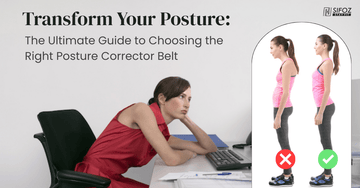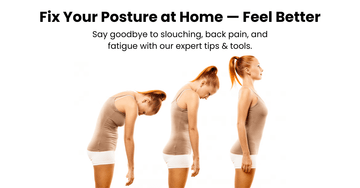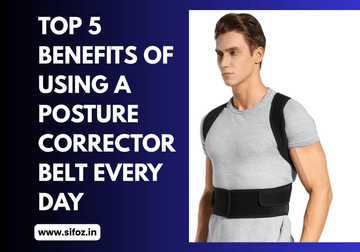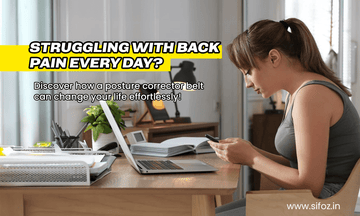Transform Your Posture: The Ultimate Guide to Choosing the Right Posture Corrector Belt

In today's fast-paced world, slouching at a desk or hunching over a screen has become all too common, leading to discomfort and long-term health issues. If you’ve felt the strain on your back or neck, it might be time to take action. With the right posture corrector belt, you can not only alleviate pain but also transform your overall health and confidence. This ultimate guide will help you navigate the sea of options available, ensuring you choose a posture corrector that fits your body type, lifestyle, and specific needs. From understanding the different types of posture correctors to tips on how to wear and maintain them effectively, we’ve got you covered. Dive in and discover how elevating your posture can change your life for the better, one strap at a time! Say goodbye to discomfort and hello to a more aligned and resilient you—your journey to better posture starts here!
Transform Your Posture: The Ultimate Guide to Choosing the Right Posture Corrector Belt
Understanding Posture and Its Importance
Posture is more than just standing up straight; it’s a fundamental aspect of your overall health. Proper posture aligns your body correctly, reducing the strain on muscles and ligaments while supporting efficient movement and balance. When your body is in alignment, it functions optimally, allowing for better breathing, improved circulation, and reduced wear and tear on joint surfaces. This, in turn, can prevent conditions such as arthritis and chronic pain. Additionally, good posture can lead to enhanced physical appearance and increased confidence.

Poor posture, on the other hand, can lead to numerous health issues, including back and neck pain, headaches, and even digestive problems. It can cause muscles to become imbalanced, leading to compensatory movements and further strain. Over time, this can result in chronic conditions and a decrease in quality of life. Understanding the importance of maintaining proper posture is the first step in preventing these issues and promoting overall well-being.
In today's sedentary lifestyle, where many spend long hours sitting at desks or hunching over screens, maintaining good posture has become increasingly challenging. This underscores the need for awareness and proactive measures to ensure that our bodies remain healthy and aligned, despite the demands of modern life.
Common Causes of Poor Posture
Several factors can contribute to poor posture, with one of the most prominent being prolonged sitting. Many people work desk jobs that require them to sit for extended periods, often in chairs that do not provide adequate support. This can lead to slumping or hunching forward, putting strain on the spine and surrounding muscles. Additionally, the use of smartphones and other electronic devices encourages a forward head posture, further exacerbating the problem.
Another common cause of poor posture is muscle imbalances. When certain muscles become tight and overactive while others become weak and underactive, it can pull the body out of alignment. For instance, tight chest muscles combined with weak upper back muscles can lead to rounded shoulders. Similarly, tight hip flexors and weak glutes can cause an anterior pelvic tilt. These imbalances often result from repetitive movements, poor ergonomics, or lack of physical activity.
Emotional and psychological factors can also play a role in poor posture. Stress, anxiety, and depression can lead to muscle tension and changes in posture. When we are stressed or feeling low, we tend to adopt a more closed-off, protective posture, such as hunching our shoulders or curling into ourselves. Over time, this can become habitual, further contributing to poor posture and the associated health issues.
What is a Posture Corrector Belt?
A posture corrector belt is a device designed to help improve and maintain proper posture by providing support and alignment to the spine and shoulders. These belts are typically made from a combination of flexible and supportive materials, such as neoprene, elastic, and breathable fabrics. They are worn around the shoulders and upper back, gently pulling the shoulders back and aligning the spine to promote a more upright posture.
Posture corrector belts come in various designs and sizes to accommodate different body types and needs. Some are more rigid and provide substantial support, while others are more flexible and allow for a greater range of motion. The goal of a posture corrector belt is to retrain the muscles and promote muscle memory, encouraging the wearer to maintain proper posture even when not wearing the device.
Using a posture corrector belt can be an effective way to address poor posture, especially when combined with other posture-improving practices such as exercise, stretching, and ergonomic adjustments. By providing external support, these belts can help alleviate discomfort and prevent further strain on the muscles and joints, ultimately leading to better overall health and well-being.
Benefits of Using a Posture Corrector Belt
One of the primary benefits of using a posture corrector belt is pain relief. By encouraging proper alignment of the spine and shoulders, these belts can help alleviate discomfort caused by poor posture. Many people experience relief from chronic back, neck, and shoulder pain after consistently using a posture corrector belt. This pain relief can significantly improve quality of life, allowing individuals to engage in daily activities with greater ease and comfort.
Another significant benefit is the improvement in physical appearance and confidence. Good posture not only makes you look taller and more poised but also exudes confidence and competence. When you stand tall with your shoulders back, you create a positive impression on others and feel more self-assured. This boost in confidence can have a ripple effect, positively impacting various aspects of your personal and professional life.
Using a posture corrector belt can also enhance overall health and well-being. Proper posture promotes better breathing and circulation, which are essential for optimal bodily functions. When your body is in alignment, your organs can function more efficiently, reducing the risk of health issues such as digestive problems and cardiovascular strain. Additionally, maintaining good posture can prevent muscle imbalances and joint wear, reducing the likelihood of developing chronic conditions and injuries.
How to Choose the Right Posture Corrector Belt
Choosing the right posture corrector belt involves considering several factors to ensure it meets your specific needs and preferences. The first consideration is the fit and size of the belt. It is essential to select a belt that fits your body type comfortably and provides adequate support without causing discomfort. Many posture corrector belts come with adjustable straps, allowing you to customize the fit to your body. Be sure to measure your chest and waist accurately and refer to the sizing chart provided by the manufacturer.
Another important factor to consider is the level of support provided by the belt. Some posture corrector belts are designed for mild support and are more flexible, making them suitable for everyday use and activities. Others offer more rigid support and are ideal for individuals with severe posture issues or those recovering from injuries. Consider the severity of your posture problems and choose a belt that provides the appropriate level of support for your needs.
Material and breathability are also crucial factors to consider. Since you may be wearing the belt for extended periods, it is essential to choose one made from comfortable, breathable materials that do not cause irritation or excessive sweating. Look for belts made from high-quality fabrics such as neoprene, elastic, and breathable mesh. Additionally, consider the ease of putting on and taking off the belt, as well as the ease of cleaning and maintenance.
Types of Posture Corrector Belts Available
There are several types of posture corrector belts available, each designed to address specific posture issues and provide varying levels of support. One common type is the shoulder brace posture corrector, which is worn around the shoulders and upper back. This type of belt gently pulls the shoulders back and aligns the spine, promoting an upright posture. Shoulder brace posture correctors are suitable for individuals with rounded shoulders and upper back pain.
Another type of posture corrector belt is the full back brace, which provides support to the entire back, including the lower back. This type of belt is ideal for individuals with more severe posture issues or those experiencing lower back pain. Full back braces offer more comprehensive support and are often more rigid, helping to maintain proper alignment throughout the entire spine.
There are also posture corrector belts designed specifically for the lower back. These belts provide support to the lumbar region and help alleviate lower back pain caused by poor posture. They are often used by individuals who spend long hours sitting or standing and need additional support for the lower back. Lower back posture corrector belts are typically more flexible and allow for a greater range of motion, making them suitable for everyday use and activities.
Tips for Using a Posture Corrector Belt Effectively
To get the most out of your posture corrector belt, it is essential to use it correctly and consistently. Start by wearing the belt for short periods, gradually increasing the duration as your body adjusts. This will help prevent discomfort and allow your muscles to adapt to the new alignment. Initially, aim to wear the belt for 15-30 minutes a day, gradually increasing to a few hours as needed.
Pay attention to your body's signals and adjust the belt as necessary. The belt should provide support without causing pain or restricting movement. If you experience discomfort or pain while wearing the belt, it may be too tight or not fitted correctly. Adjust the straps to ensure a comfortable fit and provide the appropriate level of support. It is also essential to take breaks and remove the belt periodically to allow your muscles to rest and prevent over-reliance on the device.
Incorporate complementary practices to enhance the effectiveness of the posture corrector belt. Engage in regular exercises and stretches that target the muscles responsible for maintaining good posture. Strengthening the core, back, and shoulder muscles will help support proper alignment and reduce the need for external support. Additionally, make ergonomic adjustments to your workspace and daily activities to promote better posture and minimize strain on your body.
Potential Drawbacks of Posture Corrector Belts
While posture corrector belts can be beneficial, they also have potential drawbacks that should be considered. One of the main concerns is over-reliance on the device. Wearing a posture corrector belt for extended periods can lead to muscle weakness and dependency, as the muscles responsible for maintaining proper posture may become underused. It is essential to use the belt as a temporary aid while working on strengthening the muscles and improving posture through other means.
Another potential drawback is discomfort or irritation caused by the belt. Some individuals may experience skin irritation, chafing, or discomfort from wearing the belt, especially if it is not fitted correctly or made from non-breathable materials. It is crucial to choose a high-quality belt made from comfortable and breathable fabrics and to ensure a proper fit to minimize these issues. Taking breaks and allowing the skin to breathe can also help prevent irritation.
There is also the possibility of incorrect usage leading to further posture issues. If the belt is not worn correctly or is too tight, it can cause strain on other parts of the body and exacerbate posture problems. It is essential to follow the manufacturer's instructions and seek guidance from a healthcare professional if needed to ensure proper usage and avoid potential complications.
Complementary Practices for Better Posture
In addition to using a posture corrector belt, incorporating complementary practices can significantly enhance your posture and overall health. One of the most effective practices is engaging in regular exercise that targets the muscles responsible for maintaining good posture. Strengthening the core, back, and shoulder muscles through exercises such as planks, rows, and shoulder presses can provide the necessary support for proper alignment.
Stretching is another crucial practice for improving posture. Tight muscles can pull the body out of alignment, leading to poor posture. Incorporating regular stretching routines that target the chest, hip flexors, and hamstrings can help alleviate muscle tightness and promote better posture. Yoga and Pilates are excellent options for stretching and strengthening the muscles, improving flexibility, and promoting overall body awareness.
Ergonomic adjustments to your workspace and daily activities can also play a significant role in maintaining good posture. Ensure that your desk, chair, and computer setup are ergonomically designed to support proper alignment. Use a chair with adequate lumbar support, position your computer screen at eye level, and keep your feet flat on the floor. Additionally, practice good posture habits throughout the day, such as standing up and moving around regularly, avoiding crossing your legs while sitting, and maintaining an upright posture while walking and standing.
Conclusion: Investing in Your Posture Health
Investing in your posture health is one of the most valuable actions you can take for your overall well-being. Proper posture not only enhances your physical appearance and confidence but also promotes better health and prevents a range of issues associated with poor alignment. By choosing the right posture corrector belt and incorporating complementary practices such as exercise, stretching, and ergonomic adjustments, you can achieve and maintain good posture, leading to a healthier and more resilient body.
A posture corrector belt can be a valuable tool in your journey to better posture, providing the support and alignment needed to retrain your muscles and promote proper alignment. However, it is essential to use the belt correctly and not become overly reliant on it. Combining the use of a posture corrector belt with other posture-improving practices will yield the best results and ensure long-term benefits.
Your journey to better posture starts with awareness and a commitment to making positive changes. By taking proactive steps to improve and maintain good posture, you can alleviate discomfort, enhance your physical appearance and confidence, and promote overall health and well-being. Say goodbye to discomfort and hello to a more aligned and resilient you—your journey to better posture starts here!




